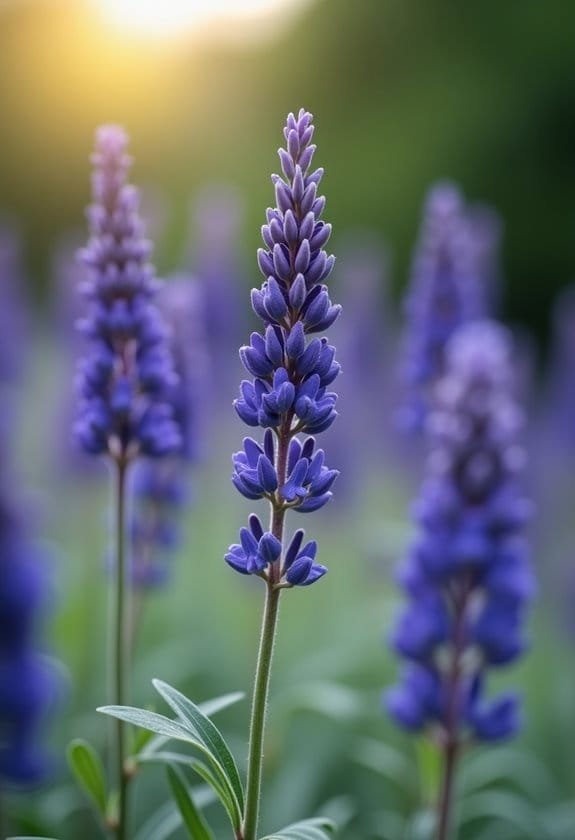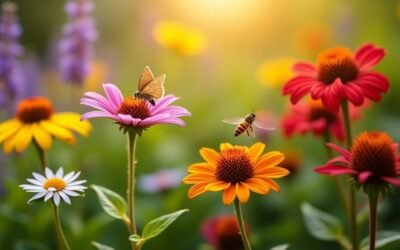Lavandula × intermedia, commonly known as lavandin, is a vigorous hybrid cross between English lavender and spike lavender that exhibits exceptional aromatic qualities. This robust plant reaches heights of 2-3 feet and produces abundant purple-blue blooms from July through September. It's distinguished by its high camphor content, which creates an intense fragrance valued in commercial production. Lavandin thrives in full sun with well-drained soil and demonstrates remarkable drought tolerance once established. Popular cultivars like 'Grosso' and 'Phenomenal' showcase the hybrid's versatility in USDA zones 5-9, where proper spacing and maintenance reveal its full potential for both ornamental and practical applications.
Main Points
- Lavandin is a hybrid cross between Lavandula angustifolia and Lavandula latifolia, known for its exceptional fragrance and high camphor content.
- It grows 2-3 feet tall, producing abundant purple-blue blooms from July to September with silvery-grey foliage.
- The plant thrives in full sun with well-drained soil, showing excellent drought tolerance once established in USDA zones 5-9.
- Popular cultivars like Grosso and Phenomenal are widely used commercially for essential oils and ornamental garden displays.
- Regular pruning in spring, proper spacing, and good drainage help prevent common issues like root rot and powdery mildew.
Introduction

Lavandin (Lavandula × intermedia) stands as a remarkable hybrid species that emerged from the crossbreeding of Lavandula angustifolia and Lavandula latifolia.
This versatile perennial has captivated gardeners and commercial growers alike with its robust growth habit, reaching heights of 2-3 feet, and its distinctive silvery-grey foliage.
The plant's exceptional fragrant qualities and higher camphor content make it particularly valuable for essential oil production, with popular cultivars like Grosso and Phenomenal leading the commercial market.
Common Name
Known throughout the gardening world, Lavandula × intermedia goes by two primary common names: Hybrid Lavender and Lavandin. These names directly reflect the plant's unique heritage as a cross between English Lavender and Portuguese Lavender, making it a true botanical bridge between two distinguished varieties.
The pronunciation of its scientific name, lah-VAN-dew-lah in-ter-MEE-dee-uh, carries the melodic quality of its Latin origins, while its common names offer gardeners and cultivators a more approachable way to reference this versatile hybrid.
Lavandin's widespread recognition in both commercial and residential settings stems from its exceptional fragrance and productive nature, flowering abundantly from July through September.
The dual nomenclature serves a practical purpose in different contexts, with "Hybrid Lavender" often preferred in horticultural circles to emphasize its cultivated origins, while "Lavandin" is frequently used in commercial applications, particularly in the essential oil industry.
This naming convention has helped establish the plant's identity in both ornamental gardening and culinary applications, where its edible components – from leaves to petals – have found their place in modern cuisine.
Scientific Name
At the heart of botanical classification, Lavandula × intermedia represents a remarkable hybrid cross between Lavandula angustifolia and Lavandula latifolia. This scientific designation, featuring the "×" symbol, explicitly indicates its hybrid nature, combining the robust characteristics of English Lavender with Portuguese Lavender's aromatic properties.
The resulting Lavandula × intermedia exhibits distinctive traits that set it apart from its parent species, particularly in its morphological structure and chemical composition. Standing 2 to 3 feet tall (60-90 cm), this semi-evergreen shrub produces exceptionally fragrant purple-blue blooms with elevated camphor levels. The scientific nomenclature reflects its intermediate position between its progenitors, hence the specific epithet "intermedia."
While sharing genetic material from both parent species, this hybrid demonstrates enhanced vigor in USDA zones 5 through 9, though it displays slightly reduced cold hardiness compared to Lavandula angustifolia.
The scientific classification acknowledges its unique position in the Lamiaceae family, where it has carved out its own identity as a commercially significant cultivar, particularly valued for its abundant flowering period from July through September.
Overview
A remarkable hybrid developed through the intersection of English and Portuguese lavender species, Lavandin stands as one of the most commercially important lavender varieties worldwide. Known scientifically as Lavandula × intermedia, this versatile plant combines the hardy characteristics of its parent species to create a robust, aromatic shrub that excels in both ornamental and industrial applications.
The plant's distinctive features include its dense, semi-evergreen growth pattern and silvery-grey linear foliage, which creates an elegant backdrop for its vibrant purple-blue flower spikes. Rising to heights between 2 and 3 feet, Lavandin commands attention in garden settings while offering practical benefits through its enhanced essential oil production.
The intermedia hybrid's increased camphor content results in a more pronounced fragrance compared to traditional English lavender, making it particularly valuable for commercial cultivation.
This adaptable plant demonstrates remarkable resilience across hardiness zones 5 through 9, with popular cultivars like Grosso and Phenomenal showcasing the species' versatility.
From July through September, Lavandin's abundant blooms provide both aesthetic appeal and valuable resources for aromatherapy, perfumery, and culinary applications.
Key Features
Lavandin stands out as a robust hybrid, reaching impressive heights of 2 to 3 feet with a dense, semi-evergreen growth pattern that creates a striking presence in any garden.
Its signature purple-blue flower spikes emerge in abundance during the peak blooming period from July through September, offering an extended display of color and fragrance.
The plant's distinctive appearance is enhanced by its silvery-green foliage, which serves as an attractive backdrop for the showy blooms while contributing to its overall architectural appeal in the landscape.
Growth Size
This resilient hybrid reaches a mature height and spread of 2 to 3 feet (60-90 cm), forming a dense, semi-evergreen shrub with distinctive silvery-grey foliage. The Lavandula × intermedia Grosso exhibits remarkable consistency in its growth pattern, creating a well-balanced, rounded form that's particularly valued in ornamental landscaping.
The plant's compact dimensions make it an ideal choice for both formal garden designs and mixed border plantings, where its mature size allows for precise spacing and planning.
During its peak blooming period from July through September, the plant maintains its structured form while producing abundant purple-blue flower spikes that crown its silvery foliage. This balanced growth habit, combined with its drought tolerance once established, creates a low-maintenance specimen that doesn't require frequent pruning to maintain its shape.
In USDA zones 5 through 9, the plant's growth remains steady and predictable, though it may show slightly more compact dimensions in colder regions. The uniform growth pattern guarantees that mature specimens create effective hedging when planted 24 to 36 inches apart.
Appearance
Stunning visual characteristics define Lavandin's presence in any garden setting. The plant's most striking features include its silvery-grey, linear foliage, which creates a sophisticated backdrop for its remarkable floral display. These leaves form a dense, shrub-like structure that contributes to the plant's architectural presence in landscapes.
The crown jewel of Lavandin's appearance is its abundant purple flower spikes, which emerge in magnificent displays from July through September. Each flower stem showcases a distinctive combination of dark violet-green calyxes supporting vibrant violet corollas, creating a fascinating dual-tone effect that catches the eye. The purple-blue blooms stand proudly above the foliage, offering an impressive visual contrast against the silvery leaves.
The plant's overall aesthetic comprises a harmonious blend of color and texture, with its mature form presenting as a well-proportioned shrub that maintains its appeal throughout the growing season.
This visual composition makes Lavandin an excellent choice for both formal garden designs and naturalistic landscapes, where its structured form and rich coloration can serve as either a focal point or a complementary element.
Flowering Season
A distinct flowering period characterizes Lavandin's annual growth cycle, with its peak bloom occurring from July through September. During this time, Lavandula × intermedia produces an abundance of vibrant purple-blue flower spikes that transform gardens into aromatic havens.
The flowering season's intensity and duration can fluctuate based on environmental conditions, including temperature patterns and cultivation practices.
What makes Lavandin particularly remarkable during its flowering season is the exceptional fragrance emission, which surpasses that of other lavender varieties due to elevated camphor concentrations in its essential oils.
As the flowering season progresses into late summer, the plant begins its seed production phase, typically spanning from August through October.
To maintain ideal flowering performance, gardeners should implement strategic pruning practices once the blooming period concludes. This post-flowering maintenance not only preserves the plant's structural integrity but also sets the stage for robust blooming in subsequent seasons, ensuring the Lavandin continues its reliable annual display of color and fragrance.
Growing Requirements

Lavandin thrives in full sunlight for a minimum of six hours daily, making it an excellent choice for open garden spaces and sunny borders.
The plant's success depends heavily on well-drained soil conditions with a pH between 6.0 and 8.0, while proper spacing of 2-3 feet between plants guarantees ideal air circulation and robust development.
These hardy plants demonstrate remarkable drought tolerance once established, requiring only occasional watering during extended dry spells and maintaining their vigor across a broad temperature range, particularly in Mediterranean-style climates.
Light
Ideal light exposure plays an important role in growing healthy lavandin plants. Lavandula × intermedia requires a minimum of six hours of direct sunlight daily to achieve its full growth potential and produce an abundance of fragrant flowers. Without adequate sunlight, these Mediterranean natives often develop weak, stretched stems and produce fewer blooms, compromising their ornamental value.
The relationship between lavandin and sunlight extends beyond basic survival requirements to influence the plant's overall structure and productivity. When positioned in partial shade or areas that receive filtered light, these aromatic herbs respond by reaching desperately toward available light sources, resulting in sparse, elongated growth patterns that gardeners often describe as "leggy."
To prevent such undesirable growth habits, it's important to select planting locations that maximize sun exposure throughout the day. While lavandin demonstrates remarkable drought tolerance, it shows little flexibility regarding light requirements, making proper placement vital for success.
Experienced growers recommend southern or western exposures, where plants can bask in full sunshine while maintaining the proper spacing of 2 to 3 feet between specimens to prevent unwanted shading from neighboring plants.
Soil
Consistently well-draining soil provides the foundation for successful lavandin cultivation. The Mediterranean heritage of Lavandula x intermedia Grosso demands specific soil conditions that mirror its native habitat, where rocky, sandy substrates naturally prevent water accumulation around the roots.
These plants have evolved to thrive in soil with pH levels ranging from 6.0 to 8.0, making them adaptable to both neutral and moderately alkaline environments.
Creating the ideal growing medium requires a thoughtful balance of soil components that promote both drainage and root development. Like their wild ancestors, these aromatic perennials flourish in sandy or rocky soils that allow excess moisture to percolate freely, preventing the devastating effects of root rot and fungal diseases.
Strategic mulching practices can enhance soil moisture retention while maintaining essential airflow, though gardeners must exercise caution to avoid creating overly damp conditions.
When establishing new plantings, spacing becomes vital; allowing 2 to 3 feet between each specimen guarantees proper air circulation and root development. This spacing technique, combined with well-draining soil, creates a microenvironment that closely resembles the plant's natural Mediterranean growing conditions.
Water
Proper water management plays an essential role in lavandin cultivation, particularly during the plant's initial establishment phase. During the important post-planting period, thorough watering helps develop a robust root system, though careful monitoring is essential to prevent waterlogging in the soil.
Once lavandin establishes itself, its remarkable drought tolerance becomes evident, transforming it into a low-maintenance addition to any garden landscape. The plant's water requirements diminish considerably, necessitating only occasional irrigation to maintain healthy growth and vibrant blooming.
During periods of extreme heat or prolonged drought, however, supplemental watering may become necessary to sustain the plant's vitality and flowering capacity.
To optimize water retention and regulate soil temperature, applying a layer of mulch around the plant's base proves highly beneficial. This practice complements lavandin's natural drought resistance while maintaining consistent moisture levels in the root zone.
When combined with full sun exposure and well-draining soil conditions, proper water management creates an ideal environment for lavandin to thrive, preventing common issues like root rot while promoting vigorous growth.
Temperature
Lavandin plants demonstrate remarkable adaptability across hardiness zones 5 through 9, with some varieties surviving even in zone 4 when provided adequate winter protection.
Unlike its less hardy Mediterranean cousins, Lavandula × intermedia exhibits impressive resilience to temperature fluctuations, making it a versatile choice for diverse climates throughout the United States.
These robust plants thrive in environments where temperatures maintain a balanced rhythm between seasonal extremes, though they require full sun exposure to reach their best growing potential.
During the summer months, Lavandin tolerates high temperatures exceptionally well, channeling its Mediterranean heritage through drought-resistant characteristics and heat-loving nature.
Winter survival depends greatly on proper cultivation practices, including adequate air circulation and well-drained soil to prevent frost damage to the root system.
While these hybrids demonstrate greater cold hardiness than traditional French lavenders, gardeners in zones 4 and 5 should consider applying a protective mulch layer around the plant's base during severe winter conditions.
Spring temperatures prove essential for establishment, as young plants require consistently warm soil temperatures above 55°F (13°C) for successful root development.
Pollinator Criteria
Lavandin's abundant purple-blue flowers serve as powerful magnets for essential pollinators, particularly bees and butterflies seeking nectar and pollen resources.
The plant's strong fragrance and extended blooming period from July through September align perfectly with peak pollinator activity in temperate zones, making it an invaluable addition to pollinator-friendly landscapes.
Its dense, bushy structure offers both sustenance and shelter to beneficial insects, contributing considerably to garden biodiversity and ecosystem stability through cross-pollination activities.
Attracted Pollinators
The abundant purple-blue flowers of Lavandin serve as a powerful magnet for essential pollinators, particularly bees and butterflies. Lavandula × intermedia's strong fragrant blooms create an irresistible attraction, drawing these beneficial insects throughout the summer months with their nectar-rich offerings.
During the peak blooming period from July to September, the plant becomes a bustling hub of pollinator activity, with its dense flower spikes providing an ideal foraging environment. The intricate structure of Lavandin's flowering stems creates multiple landing platforms, allowing various pollinator species to access the nectar simultaneously, which enhances the overall ecological value of the plant.
The plant's robust growth habit and prolonged flowering period make it an exceptional resource for supporting local pollinator populations. By establishing itself as a reliable food source, Lavandin plays a vital role in maintaining ecosystem balance and biodiversity.
Gardeners who incorporate this versatile hybrid into their landscapes contribute greatly to pollinator conservation efforts, as the plant provides sustained nourishment during critical summer months when many other nectar sources may be scarce.
Pollination Method
Successful pollination in this hybrid lavender relies on specific pollinator characteristics and behaviors. The process occurs during peak flowering months from July through September, when the plant's vivid purple-blue blooms release their strongest fragrance to attract suitable pollinators.
The pollination mechanism depends heavily on flying insects, particularly bees and butterflies, which are drawn to Lavandin's high nectar content and distinctive camphor-rich aroma. As these pollinators move between flowers, they transfer pollen grains effectively across the dense flower spikes, facilitating cross-pollination throughout the plant population.
The structure of Lavandin's flowers has evolved to maximize this interaction, providing landing platforms and nectar guides that direct pollinators to the reproductive structures. This strategic pollination approach leads to successful seed formation between August and October, ensuring the plant's reproductive success.
The combination of abundant nectar rewards, properly timed blooming periods, and the shelter provided by the plant's bushy growth creates an ideal environment for sustained pollinator activity, resulting in consistent and reliable pollination outcomes throughout the growing season.
Care & Maintenance

Successful Lavandin cultivation begins with proper planting in full-sun locations, ensuring plants are spaced 2-3 feet apart in well-drained soil that promotes healthy root development.
While newly planted Lavandin requires consistent moisture, established plants demonstrate remarkable drought tolerance and thrive with minimal irrigation, making them excellent choices for water-conscious gardens.
Spring pruning maintains the plant's compact form and encourages prolific blooming, while a protective layer of mulch helps regulate soil temperature and preserve essential moisture throughout the growing season.
Planting Tips
Growing robust lavandin plants requires attention to several key conditions for ideal health and flowering. Lavandula × intermedia thrives when given proper spacing and sunlight exposure, making site selection essential for successful cultivation. These aromatic herbs demand at least six hours of direct sunlight daily to achieve their full flowering potential and characteristic fragrance.
Proper soil preparation serves as the foundation for healthy lavandin growth, with well-drained conditions being critical to prevent root complications. Gardeners should space their plants 2 to 3 feet apart, creating sufficient airflow that minimizes fungal issues and promotes vigorous development.
After establishing the initial planting, thorough watering helps settle the soil around the roots, while a protective mulch layer aids in moisture retention during establishment.
The timing of maintenance activities greatly impacts plant health, with spring pruning being ideal for encouraging new growth. While initial care requires consistent attention to watering, established plants demonstrate remarkable drought tolerance, though occasional deep watering during extended dry periods supports continued liveliness and abundant blooming throughout the growing season.
Ongoing Care
Three vital practices form the backbone of lavandin maintenance: annual pruning, strategic watering, and consistent mulching. Cultivars like Hidcote Giant and Impress Purple, which grow larger than English Lavender, require meticulous attention to these fundamentals for peak growth.
While lavandin's drought-tolerant nature makes it relatively low-maintenance, proper ongoing care guarantees robust flower spikes and extended blooming periods. After flowering, gardeners should prune the plants before September, removing spent blooms and shaping the foliage to maintain their distinctive form.
Though resilient in well-drained soil and full sun conditions, these hardy plants benefit from occasional deep watering during prolonged dry spells.
A generous layer of mulch around the plant's base serves multiple purposes: it conserves precious moisture, suppresses unwanted weed growth, and helps regulate soil temperature.
While lavandin typically resists common garden ailments, regular monitoring for pests and diseases remains vital for early intervention. Those who harvest cut flowers should time their collection to coincide with the natural pruning schedule, maximizing both ornamental value and plant health.
Suggested Companions
An array of compatible garden companions enhances lavandin's natural beauty while promoting a thriving ecosystem.
Lavandula × intermedia's purple flower spikes create stunning visual harmony when paired with drought-tolerant companions like rosemary and sage, which share similar cultural requirements for full sun exposure and well-drained soils.
The phenomenal violet flowers of lavandin grow larger and more impressive when strategically planted alongside flowering perennials such as echinacea and black-eyed Susans.
These companion plants not only create an enchanting display but also attract beneficial pollinators to the garden.
In sandy or rocky soils, hardy plants like yarrow and sedum complement lavandin's growth habits while contributing to overall garden health.
When planning companion plantings, it's crucial to space Lavandula × intermedia plants 2 to 3 feet apart, allowing proper air circulation between specimens.
Regular pruning after flowering benefits both lavandin and its companions by maintaining ideal growing conditions.
This thoughtful combination of plants creates a sustainable garden ecosystem where each species contributes to the collective success of the planting scheme.
Common Issues
Lavandin faces several significant pest and disease challenges, with root rot emerging as a primary concern when plants are subjected to poor drainage conditions and excessive moisture.
Common invaders include persistent aphids and spider mites, which can weaken the plant's vigor by feeding on its foliage and stems.
While these issues can seem intimidating, they're manageable through a combination of proper cultural practices, including well-draining soil amendments, careful irrigation management, and timely applications of organic pest control methods.
Pests/Diseases
While generally pest-resistant, these aromatic hybrids can face several common challenges in the garden. Among the most frequent pests are aphids and spider mites, which can be effectively managed through natural predator introduction or applications of insecticidal soap.
Thrips pose another significant threat, causing leaf discoloration and distortion that can compromise the plant's aesthetic appeal and vigor.
In terms of diseases, fungal infections represent the primary concern for Lavandin growers. Root rot and lavender leaf spot often emerge in poorly draining soils, acting like silent saboteurs beneath the surface.
Powdery mildew, appearing as a white, dusty coating on foliage, thrives in humid conditions where air circulation is limited. This fungal invader particularly flourishes when water lingers on leaves from overhead irrigation.
Prevention remains the most effective strategy against these challenges. Planting Lavandin in full sun with proper spacing creates an environment where diseases struggle to establish themselves.
Regular monitoring, combined with targeted interventions such as neem oil applications, helps maintain plant health while preserving the natural pest resistance these hybrids are known for.
Solutions
Several common issues affecting Lavandin can be effectively managed through targeted solutions. By implementing proper drainage and soil aeration techniques, gardeners can greatly reduce the risk of root rot, which often plagues these aromatic plants in waterlogged conditions.
To produce more flower spikes and maintain ideal plant health, strategic spacing of 2 to 3 feet between plants promotes essential air circulation, while careful watering practices help prevent the development of powdery mildew.
Post-flowering pruning serves multiple purposes: it maintains the plant's aesthetic appeal, stimulates robust new growth, and protects tender shoots from winter damage. When pest problems arise, the introduction of beneficial insects offers a natural defense against common invaders like aphids and spider mites, creating a balanced ecosystem within the garden.
For plants showing signs of decline, such as diminished blooming or stunted growth, a soil nutrient analysis followed by the application of a balanced fertilizer can rejuvenate the plant's vigor.
These solutions, when implemented systematically, create ideal growing conditions that support healthy, flourishing Lavandin plants throughout their growing cycle.
Summary

As a versatile hybrid lavender, Lavandula × intermedia combines the best traits of its parent species, producing a hardy, aromatic shrub that grows 2-3 feet tall with silvery-grey foliage and vibrant purple-blue flowers.
This remarkable hybrid, commonly known as Lavandin, has earned its place in both commercial cultivation and home gardens due to its exceptional adaptability and aromatic properties.
Distinguished varieties like Phenomenal showcase the hybrid's superior characteristics, particularly its impressive winter hardiness and capacity for repeated blooming throughout the growing season.
The plant's high camphor content results in an intensified fragrance that's highly sought after in aromatherapy, perfumery, and culinary applications.
While slightly less cold-hardy than English lavender, Lavandin demonstrates remarkable resilience in USDA zones 5-9, thriving with minimal maintenance in full sun exposure and well-drained soils.
Its semi-evergreen nature and manageable growth habit make it an excellent choice for gardeners seeking a low-maintenance yet rewarding plant.
Through thoughtful breeding and selection, Lavandula × intermedia continues to exemplify the successful marriage of ornamental beauty and practical utility in modern horticulture.


